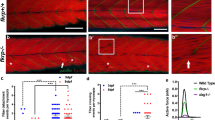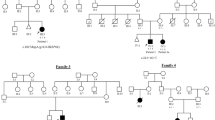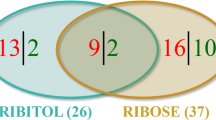Abstract
Mutations in the fukutin-related protein (FKRP) gene have been associated with dystroglycanopathies, which are common in Europe but rare in Asia. Our study aimed to retrospectively analyze and characterize the clinical, myopathological and genetic features of 12 Chinese patients with FKRP mutations. Three patients were diagnosed with congenital muscular dystrophy type 1C (MDC1C) and nine patients were diagnosed with limb girdle muscular dystrophy type 2I (LGMD2I). Three muscle biopsy specimens had dystrophic changes and reduced glycosylated α-dystroglycan staining, and two showed reduced expression of laminin α2. Two known and 13 novel mutations were identified in our single center cohort. Interestingly, the c.545A>G mutation was found in eight of the nine LGMD2I patients as a founder mutation and this founder mutation in Chinese patients differs from the one seen in European patients. Moreover, patients homozygous for the c.545A>G mutation were clinically asymptomatic, a less severe phenotype than in compound heterozygous patients with the c.545A>G mutation. The 13 novel mutations of FKRP significantly expanded the mutation spectrum of MDC1C and LGMD2I, and the different founder mutations indicate the ethnic difference in FKRP mutations.
Similar content being viewed by others
Log in or create a free account to read this content
Gain free access to this article, as well as selected content from this journal and more on nature.com
or
References
Brockington, M., Blake, D. J., Prandini, P., Brown, S. C., Torelli, S., Benson, M. A. et al. Mutations in the fukutin-related protein gene (FKRP) cause a form of congenital muscular dystrophy with secondary laminin alpha2 deficiency and abnormal glycosylation of alpha-dystroglycan. Am. J. Hum. Genet. 69, 1198–1209 (2001).
Brockington, M., Yuva, Y., Prandini, P., Brown, S. C., Torelli, S., Benson, M. A. et al. Mutations in the fukutin-related protein gene (FKRP) identify limb girdle muscular dystrophy 2I as a milder allelic variant of congenital muscular dystrophy MDC1C. Hum. Mol. Genet. 10, 2851–2859 (2001).
Beltran-Valero de Bernabe, D. Mutations in the FKRP gene can cause muscle-eye-brain disease and Walker-Warburg syndrome. J. Med. Genet. 41, e61–e61 (2004).
Liang, W. C., Hayashi, Y. K., Ogawa, M., Wang, C. H., Huang, W. T., Nishino, I. et al. Limb-girdle muscular dystrophy type 2I is not rare in Taiwan. Neuromuscul. Disord. 23, 675–681 (2013).
Hong, D., Zhang, W., Wang, W., Wang, Z. & Yuan, Y. Asian patients with limb girdle muscular dystrophy 2I (LGMD2I). J. Clin. Neurosci. 18, 494–499 (2011).
Kang, P. B., Feener, C. A., Estrella, E., Thorne, M., White, A. J., Darras, B. T. et al. LGMD2I in a North American population. BMC Musculoskelet. Disord. 8, 115 (2007).
Mercuri, E., Brockington, M., Straub, V., Quijano-Roy, S., Yuva, Y., Herrmann, R. et al. Phenotypic spectrum associated with mutations in the fukutin-related protein gene. Ann. Neurol. 53, 537–542 (2003).
Topaloglu, H., Brockington, M., Yuva, Y., Talim, B., Haliloglu, G., Blake, D. et al. FKRP gene mutations cause congenital muscular dystrophy, mental retardation, and cerebellar cysts. Neurology 60, 988–992 (2003).
Mercuri, E., Topaloglu, H., Brockington, M., Berardinelli, A., Pichiecchio, A., Santorelli, F. et al. Spectrum of brain changes in patients with congenital muscular dystrophy and FKRP gene mutations. Arch. Neurol. 63, 251–257 (2006).
Louhichi, N., Triki, C., Quijano-Roy, S., Richard, P., Makri, S., Meziou, M. et al. New FKRP mutations causing congenital muscular dystrophy associated with mental retardation and central nervous system abnormalities. Identification of a founder mutation in Tunisian families. Neurogenetics 5, 27–34 (2004).
Quijano-Roy, S., Marti-Carrera, I., Makri, S., Mayer, M., Maugenre, S., Richard, P. et al. Brain MRI abnormalities in muscular dystrophy due to FKRP mutations. Brain Dev. 28, 232–242 (2006).
Poppe, M., Cree, L., Bourke, J., Eagle, M., Anderson, L. V., Birchall, D. et al. The phenotype of limb-girdle muscular dystrophy type 2I. Neurology 60, 1246–1251 (2003).
de Paula, F., Vieira, N., Starling, A., Yamamoto, L. U., Lima, B., de Cassia Pavanello, R. et al. Asymptomatic carriers for homozygous novel mutations in the FKRP gene: the other end of the spectrum. Eur. J. Hum. Genet. 11, 923–930 (2003).
Schottlaender, L. V., Petzold, A., Wood, N. & Houlden, H. Diagnostic clues and manifesting carriers in fukutin-related protein (FKRP) limb-girdle muscular dystrophy. J. Neurol. Sci. 348, 266–268 (2015).
Mathews, K. D., Stephan, C. M., Laubenthal, K., Winder, T. L., Michele, D. E., Moore, S. A. et al. Myoglobinuria and muscle pain are common in patients with limb-girdle muscular dystrophy 2I. Neurology 76, 194–195 (2011).
Poppe, M., Bourke, J., Eagle, M., Frosk, P., Wrogemann, K., Greenberg, C. et al. Cardiac and respiratory failure in limb-girdle muscular dystrophy 2I. Ann. Neurol. 56, 738–741 (2004).
Alhamidi, M., Kjeldsen Buvang, E., Fagerheim, T., Brox, V., Lindal, S., Van Ghelue, M. et al. Fukutin-related protein resides in the Golgi cisternae of skeletal muscle fibres and forms disulfide-linked homodimers via an N-terminal interaction. PLoS ONE 6, e22968 (2011).
Kanagawa, M., Kobayashi, K., Tajiri, M., Manya, H., Kuga, A., Yamaguchi, Y. et al. Identification of a post-translational modification with ribitol-phosphate and its defect in muscular dystrophy. Cell Rep. 14, 2209–2223 (2016).
Henry, M. D. & Campbell, K. P. Dystroglycan inside and out. Curr. Opin. Cell Biol. 11, 602–607 (1999).
Ibraghimov-Beskrovnaya, O., Ervasti, J. M., Leveille, C. J., Slaughter, C. A., Sernett, S. W. & Campbell, K. P. Primary structure of dystrophin-associated glycoproteins linking dystrophin to the extracellular matrix. Nature 355, 696–702 (1992).
Michele, D. E., Barresi, R., Kanagawa, M., Saito, F., Cohn, R. D., Satz, J. S. et al. Post-translational disruption of dystroglycan-ligand interactions in congenital muscular dystrophies. Nature 418, 417–422 (2002).
Montanaro, F. & Carbonetto, S. Targeting dystroglycan in the brain. Neuron 37, 193–196 (2003).
Frosk, P., Greenberg, C. R., Tennese, A. A., Lamont, R., Nylen, E., Hirst, C. et al. The most common mutation in FKRP causing limb girdle muscular dystrophy type 2I (LGMD2I) may have occurred only once and is present in Hutterites and other populations. Hum. Mutat. 25, 38–44 (2005).
Sveen, M. L., Schwartz, M. & Vissing, J. High prevalence and phenotype-genotype correlations of limb girdle muscular dystrophy type 2I in Denmark. Ann. Neurol. 59, 808–815 (2006).
Krag, T. O. & Vissing, J. A new mouse model of limb-girdle muscular dystrophy type 2I homozygous for the common L276I mutation mimicking the mild phenotype in humans. J. Neuropathol. Exp. Neurol. 74, 1137–1146 (2015).
Xu, L., Lu, P. J., Wang, C. H., Keramaris, E., Qiao, C., Xiao, B. et al. Adeno-associated virus 9 mediated FKRP gene therapy restores functional glycosylation of alpha-dystroglycan and improves muscle functions. Mol. Ther. 21, 1832–1840 (2013).
Darin, N., Kroksmark, A. K., Ahlander, A. C., Moslemi, A. R., Oldfors, A. & Tulinius, M. Inflammation and response to steroid treatment in limb-girdle muscular dystrophy 2I. Eur. J. Paediatr Neurol. 11, 353–357 (2007).
Svahn, J., Streichenberger, N., Benveniste, O., Menassa, R., Michel, L., Fayolle, H. et al. Significant response to immune therapies in a case of subacute necrotizing myopathy and FKRP mutations. Neuromuscul. Disord. 25, 865–868 (2015).
Sveen, M. L., Jeppesen, T. D., Hauerslev, S., Krag, T. O. & Vissing, J. Endurance training: an effective and safe treatment for patients with LGMD2I. Neurology 68, 59–61 (2007).
Acknowledgements
We thank the doctors, patients and their families for their participation in this study, and thank the native-English-speaking scientific editors from Edanz Group for the editing of our manuscript. This work was supported by grants from the National Natural Science Foundation of China (81271400) (81571220) and the National Basic Research Program of China (2012CB944602).
Author information
Authors and Affiliations
Corresponding author
Ethics declarations
Competing interests
The authors declare no conflict of interest.
Rights and permissions
About this article
Cite this article
Fu, X., Yang, H., Wei, C. et al. FKRP mutations, including a founder mutation, cause phenotype variability in Chinese patients with dystroglycanopathies. J Hum Genet 61, 1013–1020 (2016). https://doi.org/10.1038/jhg.2016.94
Received:
Revised:
Accepted:
Published:
Issue date:
DOI: https://doi.org/10.1038/jhg.2016.94
This article is cited by
-
Clinical, pathological, imaging, and genetic characterization in a Taiwanese cohort with limb-girdle muscular dystrophy
Orphanet Journal of Rare Diseases (2020)
-
The clinical spectrum and genetic variability of limb-girdle muscular dystrophy in a cohort of Chinese patients
Orphanet Journal of Rare Diseases (2018)



